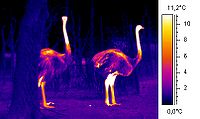
Photo from wikipedia
When dams or climate change alter the thermal regimes of rivers, conditions can shift outside optimal ranges for aquatic poikilothermic vertebrates. Plasticity in thermal performance and preference, however, may allow… Click to show full abstract
When dams or climate change alter the thermal regimes of rivers, conditions can shift outside optimal ranges for aquatic poikilothermic vertebrates. Plasticity in thermal performance and preference, however, may allow temperature-vulnerable fauna to persist under challenging conditions. To determine the effects of thermal regime on Rana boylii (Ranidae), a threatened frog species endemic to rivers of California and Oregon, we quantified tadpole thermal preferences and performance in relation to thermal conditions. We monitored temperature and censused populations across a coastal to inland cline in six catchments where dams have altered thermal environments in close proximity to river reaches with natural conditions. We found geographic variation in population distribution and abundance based on river size combined with water temperature. The large inland rivers that supported breeding frogs, although cooler in spring due to snowmelt, became warmer during the summer than occupied coastal sites. Inland populations were constrained to reaches where the average temperature over the warmest 30 days ranged from 17.6 to 24.2°C, higher than coastal rainfall-driven systems where averages ranged from 15.7 to 22.0°C. Frogs in rivers with hypolimnetic-release dams bred in colder waters than they did in free-flowing rivers. Common-garden and field translocation experiments revealed local adaptations in larval growth and phenotypically plastic thermoregulatory behaviour. Tadpoles from all rivers had a positive linear growth response to temperature, but individuals from inland rivers displayed intrinsically higher growth rates. Consistent with a counter-gradient model of selection in which the response to temperature change is in the opposite direction of the change, individuals from cooler rivers selected warmer temperatures. When reared under common conditions, however, tadpoles showed similar temperature preferences regardless of source river. Our results suggest a role for local growth rate adaptation in structuring the distribution of Rana boylii. Plastic thermoregulatory behaviour by tadpoles may explain how small populations are able to persist where dams release cold water. Management of edgewater habitats to increase the availability of warm micro-sites may ameliorate this impact.
Journal Title: Freshwater Biology
Year Published: 2017
Link to full text (if available)
Share on Social Media: Sign Up to like & get
recommendations!